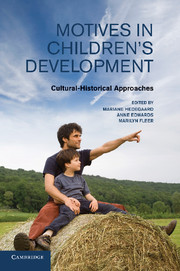Book contents
- Frontmatter
- Contents
- Figures
- Introduction
- Part One Motives, Emotions and Development
- Part Two Cultural Practice Motives and Development
- Part Three Creating Conditions for Children’s Engagement
- 10 Expertise in the Children’s Workforce
- 11 Changing Situations and Motives
- 12 A Conceptual Perspective for Investigating Motive in Cultural-Historical Theory
- Index
- References
12 - A Conceptual Perspective for Investigating Motive in Cultural-Historical Theory
from Part Three - Creating Conditions for Children’s Engagement
Published online by Cambridge University Press: 05 November 2011
- Frontmatter
- Contents
- Figures
- Introduction
- Part One Motives, Emotions and Development
- Part Two Cultural Practice Motives and Development
- Part Three Creating Conditions for Children’s Engagement
- 10 Expertise in the Children’s Workforce
- 11 Changing Situations and Motives
- 12 A Conceptual Perspective for Investigating Motive in Cultural-Historical Theory
- Index
- References
Summary
It is useful to have an explicit theoretical conception about motive. In this volume, motive refers to a theoretical concept in cultural-historical theory. As used by researchers here, motive is not located solely in a person, nor solely in a situation or condition external to a person. It describes a general relation which must be discovered analytically in the particular substantive relations in which persons are engaged. These relations transcend the individual, even whilst the individual is necessarily involved. Motives are embedded in a societal practice, not simply emerging or arising transitorily, appearing and disappearing. The concept must be studied in conjunction with other theoretical concepts, perhaps most importantly with some account of societal or ‘macro-social’ aspects. Concepts like practice, institution, tradition, values become important (see Hedegaard). In relation to a single person, motive is understood as a relation, where a person’s experience is related to, but not definitional of, motive. One could continue to rehearse these general statements, but understanding the theoretical concept of motive (in general) is only a prelude to the important scientific work of analysing motive (in specific).
The chapters in this volume are focused on understanding persons acting in their everyday situations in a particular meaningful societal practice, whether at home (Hedegaard; González Rey; Zinchenko), in preschool (Fleer; Kravtsova & Kravtsov; Sanchez & Martinez; Winther-Lindquist), school (Daniels; Stenild & Iversen; Wardekker, Boersma, van Tem, & Volman) or at work (Edwards). Most of them include analyses that discuss specific events or aspects within the practice, where the motive concept is part of the analysis for understanding either how particular forms of acting have developed or for understanding how to influence the development of concrete actions in these specific situations. In other words, the motive concept is used as part of analysing specific instances of human practices, rather than starting with the concept and seeking situations in which to apply it. This approach is consistent with the wholistic orientation of cultural-historical theory.
- Type
- Chapter
- Information
- Motives in Children's DevelopmentCultural-Historical Approaches, pp. 209 - 224Publisher: Cambridge University PressPrint publication year: 2011
References
- 6
- Cited by



